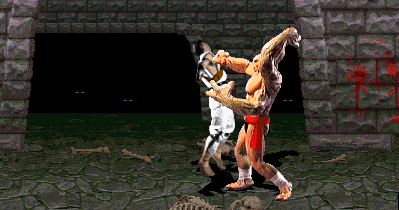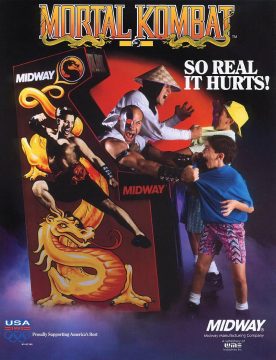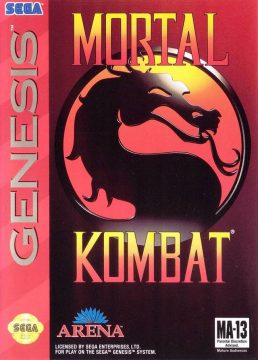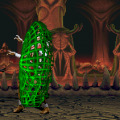- Mortal Kombat (Introduction)
- Mortal Kombat (1992)
- Mortal Kombat II
- Mortal Kombat 3
- Ultimate Mortal Kombat 3
- Mortal Kombat Trilogy
- Mortal Kombat 4
- Mortal Kombat Mythologies: Sub-Zero
- Mortal Kombat: Special Forces
- Mortal Kombat: Deadly Alliance
- Mortal Kombat Deception
- Mortal Kombat: Shaolin Monks
- Mortal Kombat Armageddon
- Mortal Kombat VS DC Universe
- Mortal Kombat (2011)
- Mortal Kombat X
- Mortal Kombat (Miscellaneous)
Somewhere on a far away island, a secretive martial arts tournament has been held for the last 500 years. The mastermind behind this tournament, Shang Tsung, is actually working for the emperor of an alternate dimension known as Outworld. This tournament is the only thing stopping the forces of Outworld from crossing into our dimension and conquering it completely. The good news is that for that to happen, Outworld has to win ten tournaments. The problem is that they’ve won nine, thanks to the help of their four-armed champion, Goro. And so, as one of seven warriors who’ve ended up on Shang Tsung’s island by either destiny or by accident, it’s up to you to make your way through the tournament and defeat the rest of Earth’s champions. Do that, and you’ll have to go against Goro, before fighting against Shang Tsung himself for the fate of the world. This is, of course, if you don’t find yourself having your spine extracted by a pissed-off ice ninja along the way.
The game itself has a strong Enter the Dragon vibe to it, with the whole idea of a secret martial arts tournament being watched over by an evil mastermind. The Hong Kong martial arts movie vibe would eventually start to fade away with time as the series continued, although bits and pieces of the concept would remain. As far as gameplay goes, however, most of the same basic concepts that show up here would be reused in the games to follow, with more elements added on for each game. The basic idea of the game isn’t far removed from Street Fighter II, with two characters, two health bars, and a timer. The game uses five buttons, two for high and low punches, two for kicks aimed high or low, and, in the first major difference from the Street Fighter series, a separate button for blocking. Also unlike Street Fighter, where only special moves would damage you while you were guarding, any blow will chip away at your life bar, so you don’t want to rely on blocking too much.
Every character shares most of the same basic moves, like sweeps, roundhouse kicks, and uppercuts, with only the speed, range, and damage of each move varying. About the only unique normal move the characters have is performed by hitting one of the punch buttons next to the opponent, which will make them do something like an elbow, headbutt, or knee attack. Throws are done by hitting one of the kicks button up close. Mashing either of the punch buttons will make your character perform a flurry of jabs. Hitting High Punch while crouching results in a mighty uppercut, a move that sends the opponent flying about 10 feet into the air with a shower of blood. Back and High Kick performs a roundhouse, while back and Low Kick does a foot sweep that’ll trip the opponent if they’re not blocking low.
Every character gets about two, sometimes three special moves, and these tend to be the only things really differentiating each character from another. Most of these moves only require you to tap two directions and a button, and none of them call for diagonals. Other moves have more unusual inputs, though, like holding down the kick button for a few seconds, or holding block and hitting the directions. It’s nice that it’s easier to pull off most of the moves compared to some of the more complicated joystick motions Street Fighter asks for, but at times it feels like they were trying too hard to be different from Capcom. The biggest issue with the game, and with a majority of the series in general, is that, aside from their special moves, the characters feel mostly identical in terms of gameplay, compared to how Capcom’s characters all felt unique in their own way.
At the end of every match, you’ll be instructed to “FINISH HIM,” (or HER, depending on the gender of your potential victim). At this point, you’re given a few seconds to get in the correct range and put in your Fatality input. If you manage to pull it off, your character will kill off the opponent in some kind of spectacularly gruesome way. Except for Liu Kang, who just does a cartwheel and an uppercut, which is apparently so lame the screen doesn’t even bother to darken for it. Some of these, although kind of silly by the standards set by today’s games, are pretty brutal for the time, like Kano tearing somebody’s heart out. You can also use your uppercut to knock your opponent off of the tiny bridge that makes up ‘The Pit’ stage, impaling them onto the spikes below. This is the first Fatality involving the stage in the series, and it wouldn’t be anywhere close to the last.
The game’s a lot more fun to play with a friend than tackling the single player mode, mostly because this was still in the era where developers would try their best to fleece you out of as many quarters as they could. While the AI starts off at a fairly reasonable level of difficulty, it quickly picks up as you move through the matches. It doesn’t get especially bad until you get to the Endurance Matches, where you have to beat two opponents on one life bar. For two rounds. It feels more or less like filler, and even worse, it feels like filler meant to take more of your money. Even if you get past the Endurance Matches, you’ve still got Goro ahead of you, who’s an absolute pain in the ass unless you figure out the cheap trick to beating him. He’s especially vulnerable to jump kicks, however. If you don’t take the cheap way out, you have to deal with his punches, which do about a fourth of your health in damage, and his grabs, which do even more. He’s also basically able to counter every single thing you do, usually grabbing you out of whatever you’re doing and pounding into you with his fists.
Get past Goro, and you’ll go up against Shang Tsung, who proves to be even more of a pain. The streams of flaming skulls he keeps firing off can take off about half your life if they aren’t blocked. He’s also able to morph into any other character in the game, including Goro. If you manage to win two rounds against him, he starts spewing all the other characters out of his body before collapsing to the ground. Thus starts the tradition of Mortal Kombat bosses having long, dramatic death animations, which helps ease the frustration of fighting them just a bit. For your efforts, you get a couple of paragraphs of text, along with a couple of still pictures. Not quite as nice as your average Street Fighter 2ending, but Raiden’s ending has a certain funny twist to it. “Have a nice day,” indeed.
Besides the fighting part, there’s also a mini game every few matches called Test Your Might, which you can do with either one or two players. You mash the low attack buttons to build up a power meter, and then hit the block button to try to break a block in front of you. Succeed, and you’ll smash whatever’s in front of you to pieces, along with getting a big score bonus. Each time you do the mini game, the block you’re trying to break gets tougher, from wood, to steel, eventually all the way up to diamond. It’s a decent diversion from the fighting, even if it’s not quite as fun as smashing up a car.
Sometimes, before a match begins, a green ninja may appear on screen and give you a cryptic message like “Perfection is the key” or “Look to La Luna.” This is Reptile, and he’s actually giving you hints on how to satisfy an incredibly difficult number of conditions you’ll have to follow if you hope to encounter him. If you manage pull this off, you meet him at the bottom of The Pit, where he’s an incredibly speedy green ninja with all of Scorpion’s and Sub-Zero’s moves. Winning against him gives you a major score bonus, if you happen to be playing for the high score. And it’s a fighting game, so why would you?
It’s much more the presentation that Mortal Kombat was known for then its gameplay, and to its credit, the game did a great job at the time of feeling like an interactive martial arts movie. The digitized sprites, although they were revolutionary at one point, now look a little blurry and lack a lot of frames in their animations. In fairness, however, they still look a lot better than games such as Pit Fighter. The sound is also pretty good for the time, with each hit giving off a loud, meaty impact. The characters also give off a lot of grunts, screams, and exclamations like “Yeah!” or “C’mere!” Performing an uppercut causes Shang Tsung to call out things like “Excellent!” or “Outstanding!”. The music is the sort of Oriental sounding stuff you’d expect to hear in a ’70s martial arts movie, although the fact that it’s played with on Yamaha sound hardware makes it sound a little tinny.
The first MK is a decent start to the series, but the later games would improve on it so much more that it serves more as a curiosity. All the famous Mortal Kombat elements are all there, like the digitized graphics, juggle combos, and Fatalities. But with such a small collection of characters, each with so few special moves, it hasn’t aged very well. It’s also missing polish compared to its successors. It’s worth playing as a fan of the series, but its sequels do everything it does so much better that you’d probably do much better playing one of those.
As with any arcade game that was as popular as Mortal Kombat was, a deluge of ports to every major system of the time would soon follow. Sega’s versions of the game generally beat out Nintendo’s versions in gameplay and content, whereas the DOS version was the best of all the home ports.
While the Genesis version might not be the prettiest of the home ports, it makes up for it by playing better than the SNES effort. The character sprites are much smaller, the backgrounds have been simplified, and the status bar has been changed so the names appear above the health meters. Most of the digitized speech has been removed, and what remains tends to sound very muffled. Shang Tsung himself sounds like he’s picked up a bad case of bronchitis. On the plus side, there’s a new soundtrack done by Matt Furniss, who does a great job remixing the arcade game’s music to sound better on the Genesis’s sound hardware. There’s even a couple of new songs that don’t appear in the arcade version. It’s more of a matter of preference whether you like it better than the arcade soundtrack, although both are decent soundtracks on their own.
The gameplay’s transferred very well from the arcade version, although the game plays much better on a six button controller. The problem with the controls is no matter what kind of controller you’re using, the start button blocks, which means you can never pause the game. The only point where you get any sort of break is during the screen where the game shows you your next opponent. Sure, other fighting games may have used the Start button to switch between punches and kicks, but they didn’t disable pausing entirely. When this port came out, however, nobody cared about that. What people played this version for was the now classic blood code. By the default, all the blood is gone from the game entirely, and some of the Fatalities were changed to be less violent. For example, Johnny doesn’t uppercut people’s heads off, he just Shadow Kicks them off the screen. However, by inputting a code at the start of the game, you’ll unlock a mode that brings back all the violence, including the original Fatalities. As you’d imagine, this led to the Genesis version utterly destroying the bloodless SNES version in sales.
The Sega CD version looks and plays almost exactly like the Genesis port, although the animation is slightly better, the life bars are closer to the arcade version, and the sound’s been improved. Most of the digitized speech from the arcade version has been brought back in, and the game uses Redbook audio to play the arcade version’s soundtrack. The blood is also on by default, which means you no longer have to enter a code to get to those delicious Fatalities. Since this is the Sega CD, however, the trade-off is that you have to deal with loading times before every fight. You also see an FMV of the “Mortal Monday” commercial when you start the game, rendered in muddy low color with glorious Sega CD compression.
The Game Gear and Master System versions are mostly identical, with a couple of differences. As you’d expect from the Game Gear’s smaller screen, everything’s a lot more scrunched in, making things hard to see. Also, Kano is missing from the roster here. Another weird difference is that while the Game Gear version uses the Start button to block like the Genesis port, on the Master System version it actually, you know, pauses the game. (Blocking with a button installed on the console would have caused some problems.) Instead, you hold back and punch to block, which makes pulling off most special moves more difficult than it should be. Actually, pulling off a special move in either version doesn’t usually actually work. And then there’s the choppy framerate and severely limited animation to deal with. Best avoided.
The Super Nintendo version looks and sounds much closer to the arcade original, although the sprites are still a little smaller. The game feels a little more sluggish than the arcade version, however, and the controls tend to be a little unresponsive. The major reason everybody hates this port, as you probably know by now, is that all the blood’s been replaced by some grey fluid that’s apparently supposed to be “sweat.” They also renamed the Fatalities “finishing moves.” Some of the Fatalities were also replaced, although a couple of them are actually pretty cool, like the one where Raiden vaporizes the opponent into a pile of dust. And while blocking has been mapped to the shoulder buttons, the Start button does absolutely nothing during a fight. Mind boggling.
The Game Boy port somehow manages to be even worse than the Game Gear version, with an even lower framerate. The controls are just as hard to use, with the special moves being almost impossible to pull off. Blocking’s done by hitting the punch and kick button together, leaving the Start button, again, entirely unused. Kano is playable in this version, but as a tradeoff, Johnny Cage isn’t. The one redeeming feature of this particular port is that by entering a code after beating the game, you get to do a second playthrough while playing as Goro. Just like the SNES version, all the gore’s been redone, and the “exclusive” finishing moves tend to be lame.
The DOS version is probably the most arcade perfect of all the ports released. It actually looks almost exactly like the arcade game, except for the fact that color pallete and resolution aren’t quite as high. It plays pretty closely to the arcade version, too. The framerate is a bit lower, but the controls work out pretty well. With the way MK handles special move inputs, entering them with a keyboard is actually fairly easy. You can play with a joystick as well, although the control setup with the joystick is a lot harder to get used to. The DOS version was released on both floppy and CD formats, with the only difference being the music. The floppy version plays the music through the soundcard, while the CD version uses Redbook audio to play the arcade game’s soundtrack, much like the Sega CD version.
The Amiga version isn’t awful, but it pales against the DOS version for a few reasons. The biggest problem with it is that you’re forced to use a joystick with a single button to actually play. And as you can imagine, trying to fit all the moves in Mortal Kombat onto one button leads to something that’s really not comfortable to play at all. Even worse, unlike the PC version, using the keyboard isn’t even an option. The character sprites look all right, but this port uses the same simplified backgrounds as the Genesis version. You also have to deal with the loading times nearly every other Amiga game had to deal with if you’re playing it off floppies, too. They did manage to fit the whole thing on two floppies, however, which is pretty impressive. The music was done by Allister Brimble, same guy who handled the music for Team 17’s early work, but there’s only a couple of songs in the game, and only one of them actually plays during the fights.
The port to the PSP, found on the Midway Arcade Treasures: Extended Play collection, is pretty decent. The only real problem is that there are a few issues with the sound. The PS2 port, found on the Platinum Pack for Deception, also plays decently, although, for some reason, it seems to run faster than the actual arcade game.
The Mortal Kombat TV Game from Jakks Pacific is yet another of those plug and play games you put the controller into the TV to play. This particular port plays pretty well, although it’s not completely accurate to the arcade version. The music ends up sounding a little worse, for one thing. The backgrounds also don’t animate like they did in the original version, so the monks in the courtyard always stay completely still. Yet the gameplay’s stayed pretty much intact, even if there are ports out there that are probably easier to find and set up. You can also link two of the controllers together for two player matches.
The port on the Arcade Kollection is arcade perfect, aside from a few issues with the audio. Some of the sound effects sound like they’ve been re-recorded entirely, which clashes with the rest of the low-fidelity audio. The online play also tends to be rather laggy, meaning you’ll probably have to find another human opponent to play with. It also comes with the standard achievements and leaderboards for these sorts of ports.
The infamous LCD handheld manufacturer Tiger also made a licensed device with the title Mortal Kombat. It’s easy to imagine how much this was like the original game…
Fatalities
Comparison Screenshots




